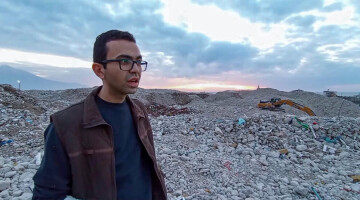Initiative to Keep Hasankeyf Alive and Hasankeyf Matters released a statement detaling the accelerating environmental and heritage destruction in Turkey’s historic city of Hasankeyf.
Environmental and heritage destruction have accelerated in Turkey’s historic city of Hasankeyf as crews work day and night, seven days a week to collapse vulnerable portions of the cliffs ringing the town and fill in some 200 caves. The work’s stated aim is to reinforce Hasankeyf’s ancient citadel ahead of completion of the Ilısu Dam, which would flood most of the town beneath approximately 60 meters of water. Preparations are also being made to construct a wall to cover the cliff face of the citadel mount. And a new road is being built across the Tigris River to haul equipment and rubble to and from the work site, significantly altering the course of the river and severely reducing its water quality.
The serious risks to both the historic heritage of Hasankeyf and the natural ecosystem of the Upper Tigris Basin posed by this work, which is being carried out without proper transparency or public involvement, are being documented by the Initiative to Keep Hasankeyf Alive (Hasankeyf’i Yaşatma Girişimi) and Hasankeyf Matters. The work to reinforce the cliffs is causing irreparable damage to the historical and cultural fabric of Hasankeyf, significantly reducing the value of the citadel and the surrounding natural rock formations as cultural heritage.
Similarly, the use of heavy equipment to collapse the cliffs beginning in August, together with the on-going construction of the new bridge one kilometre to the east of Hasankeyf, has polluted the Tigris River and is destroying extensive areas of habitat for numerous species of fish, plants and wildlife. In the course of this work, trees on the banks of the river are being cut unnecessarily and piles of debris are rising. Due to the change in the course of the Tigris, the fish habitat in the riverbed has been severely damaged for at least one and a half kilometres. Local observers report that thousands of fish have been killed.
This destruction is being done in violation of legal requirements for transparency, which require that the names of contractors and sub-contractors carrying out this work be disclosed. However, on the sign describing the work in progress, the space designated for the names of contractors and sub-contractors for the project has been left blank. Our research reveals that the contractor is the ISS Group (ICC Grup), while the sub-contractor collapsing the cliffs is Rüzgar Industrial Mountaineering (Rüzgar Endüstriyel Dağcılık). Both firms are based in Ankara.
News articles and press releases on the website of the State Hydraulic Works (DSİ), which is responsible for the Ilısu Dam Project, state that following the collapsing of cliffs around the citadel – an area that includes the hills of Ra’s Tibbah and Darphane – portions of the cliffs and surrounding valleys would be filled in with 4.75 cubic meters of debris/rubble and concrete. However, no plan for this has been shared with the public.
The failure to inform and consult the public regularly on substantive details of the citadel reinforcement project contravenes the laws of the Republic of Turkey, specifically Law Number 3534, which brought the country into legal compliance with the Council of Europe’s Convention for the Preservation of the Architectural Heritage of Europé (CETS 121). Article 14, Paragraph 1 of that law states that each party to the Convention will undertake “to establish in the various stages of the decision-making process, appropriate machinery for the supply of information, consultation and co-operation between the State, the regional and local authorities, cultural institutions and associations, and the public”.
International law mandates that intangible cultural heritage must be protected and that the public must be substantively and systematically consulted regarding projects for the conservation of immovable cultural heritage. Contrary to these legal requirements, the on-going work in and around Hasankeyf – its goals, technical plans, detailed methods and time schedule – is shrouded in extreme secrecy.
Meanwhile residents of Hasankeyf and neighbouring villages and towns are witnessing each day the dismemberment of the landscape where they and their ancestors have lived for centuries. Experiencing the dust and sounds of explosions created by this project, and seeing the destruction of historic landmarks and touchstones for collective memory, is intensifying the trauma and uncertainty they have lived with for 50 years, since the first proposal for the Ilısu Dam Project that would mean the death of their community and way of life.
As the filling and covering of cliffs is causing significant damage to the immovable historical structure of Hasankeyf and to the fabric of the town’s intangible cultural heritage, the project also violates the human right to culture upheld by the United Nations Human Rights Council Resolution 33/20.
Initiative to Keep Hasankeyf Alive and Hasankeyf Matters called again on the companies destroying the historical fabric of Hasankeyf and the Tigris Basin ecosystem to withdraw immediately from these damaging projects.















